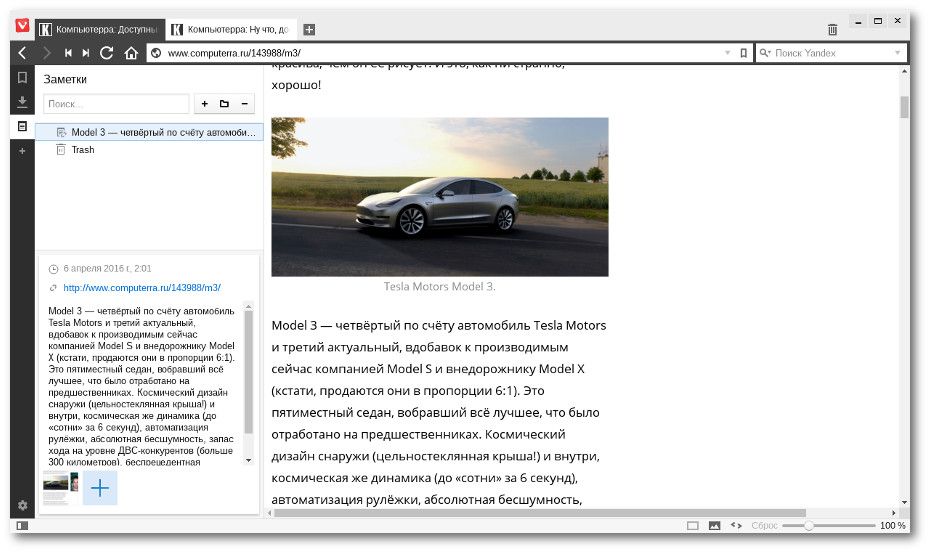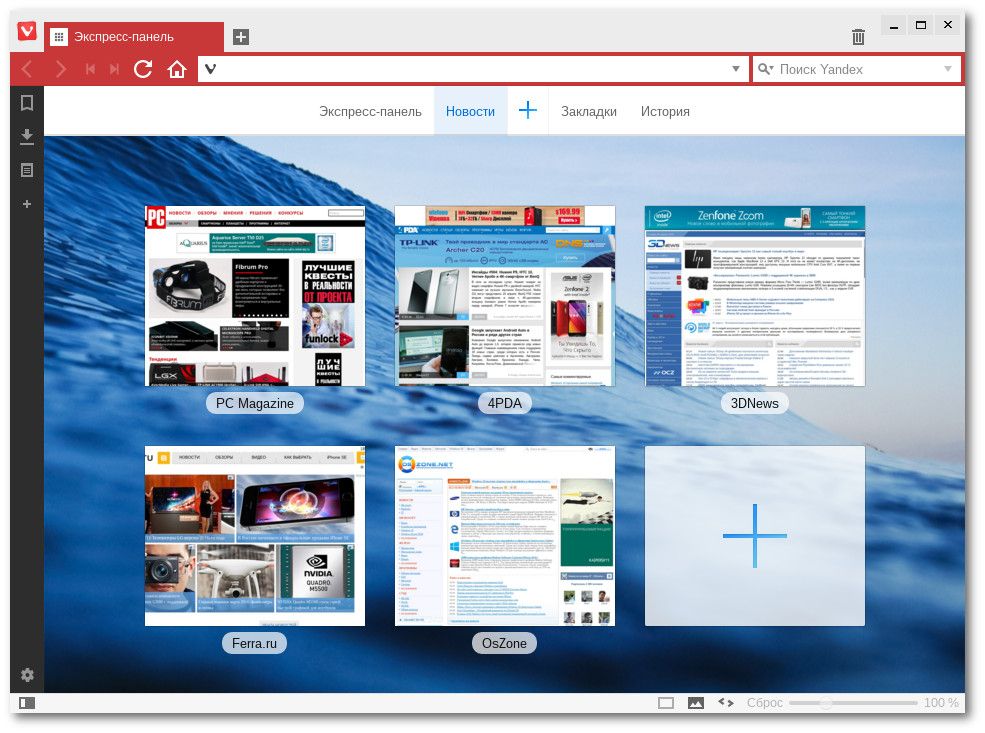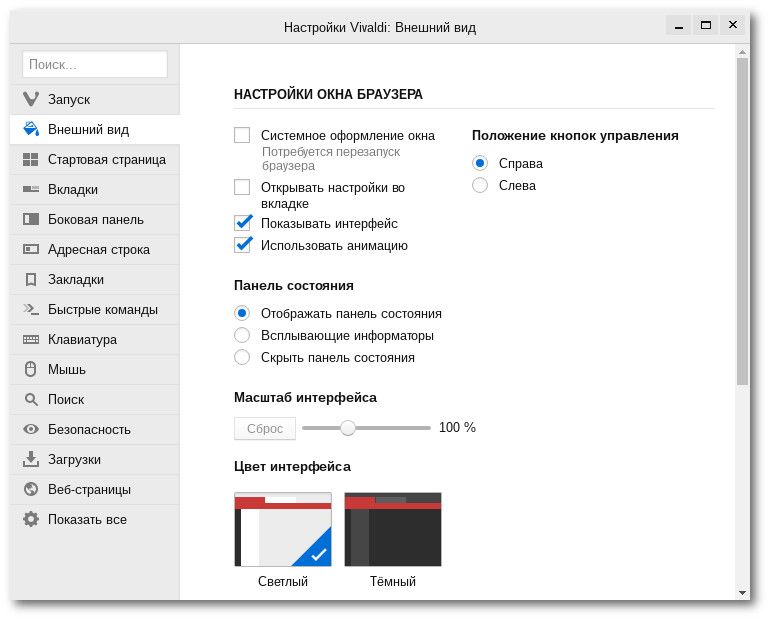Modern classic - browser Vivaldi 1.0

Hello!
Today we have with you a momentous day - the first final version of the Vivaldi browser is being published. And the generalization here is not figurative - what we have been able to do today, we have done only thanks to you, our users. You helped us test the weekly assemblies, sent us your ideas and wishes, and simply drove us on, not allowing us to relax and filon. But, most importantly, all these fourteen months from the release of the first public test version, you made us understand that you need a browser like Vivaldi, you are waiting for it and hoping that it will not disappoint your hopes.
Well, such attention is expensive. And we tried to give everything to the fullest. If you remember, once Opera browser for fifteen years went to the top of its development, filled with useful and irreplaceable functions, developing controls for the browser itself, and the content displayed in it. At the moment we are still far from that level, but what has already been done allows us to confidently say: we will go through the opera for a year or two. Look at the volume of all functions implemented to date - I am sure that the list of what you want to see in Vivaldi in addition to this will be much more modest:
List of implemented functions
- Tab grouping
- Notes
- Express panel
- Bookmark manager
- Download Manager
- Fast teams
- Mouse gestures
- Page effects
- Side panel
- Color tabs
- Visual tabs
- List of recently closed tabs
- Shortcut Keys
- Bookmarks bar
- Disable pictures
- Return / Transition
- Spatial navigation
- Placing a group of tabs in one window
- Background Pages Load Indicator
- Support for system window layout
- Auto update
- Import of personal data
- Plugins on request
- Launch settings
- Color schemes
- Interface scaling
- HiDPI support
- Fixed tabs
- Task manager
- Web panels
- Interface shutdown
- Visual tab switching
- Private window
- Informative indication of loading pages
- List of entered addresses
- Smooth scrolling
- Geolocation support
- HTML5 Audio and Video (H.264) support
- Extension support
- Fast closing tabs
- Basket in bookmarks and notes
- Turning off the side panels
- Tab Mute (STFU)
- HTML5 notifications
- Minimum font size
- Default encoding settings
- Move tabs between windows
- Export Bookmarks
- Interface scale
- Global / individual page scale
- Close tab by double click
- Color tab settings
- Manage closing / opening tabs
- Sessions
- Unloading tabs from memory
- CSS debugger
- Search Tips
- Welcome Page
- Minimize the active tab by clicking on the tab
')
If you remember, a little more than a year ago we conducted a survey among users to determine the most popular functions. The complete list contained 48 items, and today almost half of them are implemented in full or in part:

Let's look at some of these functions in more detail, but first, a couple of words.
Modern classic
As you probably already understood, the main motto of our first final version is modern classics. This means that the Vivaldi browser not only includes the most advanced technologies, but also aims to return to the browser market some classic principles that today are almost irretrievably lost by most browsers. And these principles are simple and clear: the user must by default have the browser the most accessible set of functions for networking, and the browser developers give him maximum freedom in setting up and managing, allowing the browser to flexibly adapt to his needs. To do this, of course, is much more difficult than to say, but at the moment we are coping, and in our opinion - quite well.
Tab grouping and placement
Tab grouping is one of the classic ways to restore order among dozens of open pages. It's simple: drag one tab over the other and get a group of tabs. But we decided to slightly improve this function, following the current trends in increasing the size of displays. Using the placement function, you can arrange several tabs of a group in one window and work with them simultaneously:

By the way, you can place not only the grouped tabs in this way, but also the usual ones - just select them by holding down the Ctrl key and then select the appropriate type of placement.
Notes
Here, too, traditions are combined with certain innovations. Now you can not only create a text note by highlighting the text on the page, but also save the link to the source and even a screenshot of the original page - in case it disappears over time from the network. Additionally, you can attach various files to the note, which further expands the capabilities of this classic browser function:

Web panels
Web panels for the first time, if I am not mistaken, appeared in Netscape Communicator in 1996 - it was then that an opportunity appeared in the browser sidebar to post some content. 20 years have passed, but that good idea continues to live and develop in new browsers. For example - in Vivaldi. Of course, today web panels provide users with much more features than before. And it looks more attractive from the outside - if there is a mobile version of the website, Vivaldi will use it as a web panel:

Express panel
At one time it was a very popular opera feature. So popular that almost all browsers adopted it in one form or another and today it is a real classic. Frankly, we are not very actively engaged in this component of the browser, but we have a lot of ideas. So this year you will find many pleasant surprises here too. Well, for now we have only slightly expanded the capabilities of the Express panel, adding the creation of folders. In fact, we have made it possible to create multiple Express panels and switch between them in one click. Try it - you will surely enjoy:

Settings, settings ...
If you are closely following the release of test builds, you may have noticed that almost every new version adds new settings. In fact, browser settings are a completely traditional component, without which no browser can do. But in fact, today the number of possible combinations of settings available in Vivaldi exceeds one million! It is probably difficult today to find another browser providing a similar variety. And we have just started:

It's only the beginning
Indeed, today we are only at the beginning of the journey and our browser version is proudly number 1.0. This is the starting point, the foundation on which we begin to build a new modern browser. Modern, but preserving good classical traditions, and not only preserving, but also raising them to a new, modern level. The next round of browser history has begun - let's go through it together.
That's all. Do not forget to install the first final version of the Vivaldi browser:

And also do not forget to report bugs found - we traditionally have them. :-)
Source: https://habr.com/ru/post/281020/
All Articles